Some appliance brands are more affordable than others due to a variety of factors, including their marketing strategies, the quality of materials used, and their manufacturing processes. Budget-friendly brands often opt for cost-effective materials and simpler designs, keeping their prices competitive. On the other hand, premium brands prioritize superior craftsmanship and advanced technologies, resulting in higher price points. Economic factors, such as competition and production volume, also impact pricing, with larger brands benefiting from economies of scale. Consumer perceptions and brand loyalty also influence pricing disparities. Being aware of these factors can assist you in making well-informed decisions when assessing different options.
Key Takeaways
- Lower-priced appliances often use cost-effective materials and simpler manufacturing processes, reducing production costs and retail prices.
- Economies of scale enable larger brands to lower per-unit costs, benefiting from high demand and extensive production facilities.
- Budget brands typically lack advanced technology and features, resulting in lower prices compared to premium brands that invest in innovation and quality.
- Resale Price Maintenance and exclusive distribution agreements limit competition, allowing higher-priced brands to maintain their pricing strategies.
- Consumer perception of value is influenced by brand loyalty, price sensitivity, and marketing strategies, which can further drive price disparities among brands.
Price Control Mechanisms
When manufacturers implement price control mechanisms, they can greatly impact the pricing landscape of appliances. One common method is Resale Price Maintenance (RPM), which allows manufacturers to enforce pricing agreements with retailers. This creates price uniformity across different sellers and limits competition, particularly in the high-end appliance market.
You may notice that high-end brands maintain strict pricing policies, resulting in less price variation compared to more affordable, value brands. Understanding the factors that influence pricing, such as key factors in choosing a home cleaning service, can help you make more informed purchasing decisions.
Retailers pressured by RPM are often compelled to adhere to minimum pricing, which can drive up costs for consumers seeking certain brands. Additionally, the limited number of distributors for high-end appliances contributes to consistent pricing, while value brands benefit from a broader distribution network that fosters competitive pricing.
Moreover, other price control mechanisms, such as exclusive distribution agreements, enable manufacturers to maintain control over pricing. This influence shapes the overall cost structure of various appliance brands, allowing some to command higher prices.
Understanding these price control mechanisms helps you navigate the pricing differences in the appliance market, ensuring you make an informed decision when shopping for your next home essential.
Brand Marketing Strategies
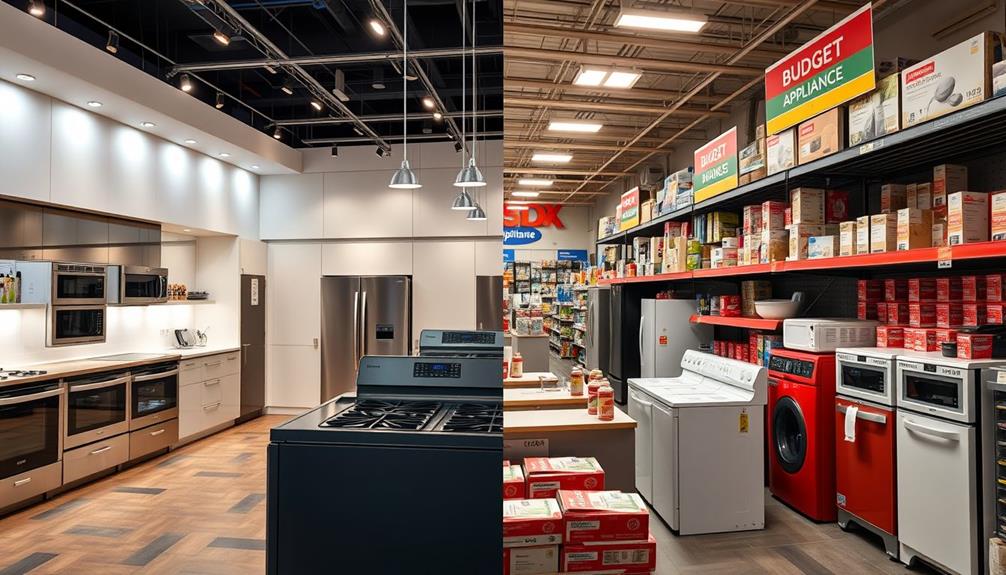
Leveraging effective brand marketing strategies is essential for appliance companies aiming to differentiate themselves in a crowded market. Value-oriented appliance brands often concentrate on providing essential features at lower prices, targeting budget-conscious consumers who prioritize affordability. By emphasizing basic functionality, these brands, like Amana and Frigidaire, manage to attract cost-sensitive shoppers.
Additionally, just as with dogs, where unique names and breeds can influence a pet owner's choice, an appliance's model name and features can similarly sway consumer preferences.
In contrast, premium appliance brands such as Samsung and LG command higher prices through strong marketing efforts that highlight quality, reliability, and advanced features. The significant disparity in brand equity plays a vital role in shaping pricing strategies, allowing premium brands to stand out despite their higher costs.
Moreover, discounts and promotions are frequently employed by lower-priced brands to enhance perceived value. Retailers often offer clearance items and special buys, making these appliances even more enticing to potential buyers.
With the average price for major appliances sitting at $922 in 2023, brands that maintain lower price points can capture market share effectively. By understanding these brand marketing strategies, you can better navigate the appliance landscape and find the best deals suited to your needs.
Manufacturing Processes Explained

When you look at appliance brands, you'll notice that cost-effective materials play a big role in their pricing.
These brands often focus on production efficiency techniques that allow them to produce more at a lower cost.
Additionally, understanding the impact of energy consumption of appliances can further inform your decisions, as energy-efficient models might save you money in the long run.
Understanding how these processes work can help you make informed choices when shopping for appliances.
Cost-Effective Materials Utilization
How do cost-effective appliance brands manage to keep their prices low while still delivering functional products? One key strategy is their use of cost-effective materials. These brands often opt for lower-priced materials like less durable plastics and basic metals, balancing affordability and functionality. Simplified manufacturing processes help minimize labor and overhead costs, allowing them to compete on price.
Additionally, many affordable appliances feature fewer advanced technologies and are designed with streamlined aesthetics. This not only decreases production complexity but also reduces the amount of material and time required for manufacturing. When brands produce large quantities of basic models, they benefit from economies of scale, lowering the cost per unit even further.
Here's a quick look at how these choices affect cost and efficiency:
| Material Type | Impact on Cost |
|---|---|
| Basic Plastics | Lower material cost |
| Simple Metals | Reduced expenses |
| Fewer Features | Decreased complexity |
| Streamlined Designs | Less manufacturing time |
| High Volume Production | Economies of scale |
Production Efficiency Techniques
In today's competitive market, appliance brands are increasingly adopting production efficiency techniques to streamline their manufacturing processes and reduce costs. Automation and lean manufacturing play essential roles in this shift, markedly lowering labor costs while maintaining quality.
By utilizing just-in-time inventory systems, brands minimize waste and reduce holding costs, enabling them to offer more competitive pricing. Additionally, brands can also benefit from potential tax advantages associated with IRA accounts by investing in gold, which could further enhance their financial strategies.
Moreover, streamlined supply chains and strategic partnerships with suppliers enhance material procurement efficiency, further driving down production costs for budget appliance brands. Advanced manufacturing processes, like injection molding and precision machining, increase output speed and consistency, allowing brands to pass on those savings to you.
Another key factor is the implementation of energy-efficient machinery in production facilities. This not only cuts operational costs but also aligns with modern sustainability practices, appealing to cost-conscious consumers who care about energy consumption.
Material Quality Variations
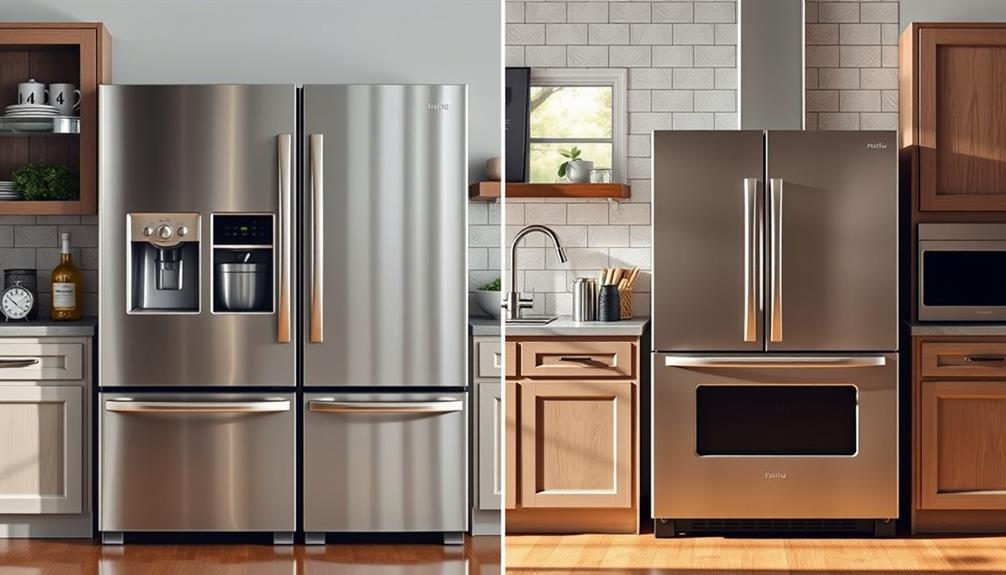
When you're comparing appliance brands, the materials they use can greatly impact durability and longevity.
Cheaper models typically rely on lower-quality components, while premium brands often incorporate advanced technology and superior craftsmanship.
For example, some garage door openers utilize modern materials and smart features that enhance security and performance.
Understanding these material quality variations will help you make an informed choice that suits your needs and budget.
Manufacturing Materials Used
Understanding the materials used in appliance manufacturing can help you make informed choices when shopping. When you look at affordable appliance brands, you'll often find they utilize lower-cost manufacturing materials, like plastic or basic metals. This choice considerably cuts down production costs compared to high-end brands that prefer premium materials such as stainless steel or high-grade composites.
Furthermore, just like the importance of utilizing sustainable practices in energy production, the choice of materials in appliances can impact their overall efficiency and environmental footprint, as seen in geothermal energy applications.
The construction quality of these budget appliances may be compromised. Thinner components and less durable finishes can lead to issues down the line. You might also notice that lower-priced models lack advanced features and technology, such as smart functionality or energy-efficient components, which are typically found in more expensive options.
Additionally, the manufacturing processes for these value brands often involve less strict quality control measures. This can result in variability in performance and durability, making the appliances feel less reliable.
While economies of scale allow these brands to offer lower prices, it often comes at the expense of material quality and long-term performance. So, when weighing your options, consider how the manufacturing materials impact not just the price but the overall value of the appliance.
Durability and Longevity
The choice of materials directly impacts the durability and longevity of your appliance. When you opt for affordable brands, you often find that they use lower-quality materials in their construction. This can lead to reduced durability and a shorter lifespan compared to premium brands that invest in higher-quality components.
Many budget appliances feature basic designs that prioritize cost savings over long-term reliability, increasing the likelihood of repairs or replacements. Additionally, adequate sleep enhances symptom management in the context of overall well-being, just as investing in quality materials can support the longevity of your appliances.
Advanced materials that enhance durability, like stainless steel exteriors or high-efficiency motors, are typically absent in lower-priced models. Consumer reports show that the average lifespan of budget appliances is often several years shorter than that of higher-end brands. While budget models might last around 5-7 years, premium options can last 10-15 years or more.
Additionally, the manufacturing processes for budget appliances may involve less rigorous quality control standards. This can lead to inconsistencies in product quality and performance over time.
Ultimately, if you value durability and longevity, investing in a higher-quality brand may save you money and hassle in the long run.
Technology Integration Levels
Many consumers may not realize how considerably technology integration levels vary between affordable and premium appliance brands. When you choose a budget appliance, you're often opting for lower-quality materials and basic construction techniques. This decision can save you money upfront, but it may cost you in energy efficiency and longevity. Premium brands invest in advanced technologies, offering features that enhance performance and reduce energy consumption.
Here's a quick comparison of the technology integration levels:
| Feature | Affordable Brands | Premium Brands |
|---|---|---|
| Material Quality | Basic materials | High-grade materials |
| Design Options | Standard finishes | Custom finishes |
| Smart Features | Limited or absent | Commonly included |
| Energy Efficiency | Lower efficiency | High efficiency |
| Longevity | Shorter lifespan | Extended lifespan |
Investing in appliances with better technology integration not only means improved performance but also significant energy savings over time. While the initial cost may be higher, these premium appliances often prove to be more cost-effective in the long run. Choose wisely to enjoy the benefits of technology in your home.
Competitive Market Dynamics
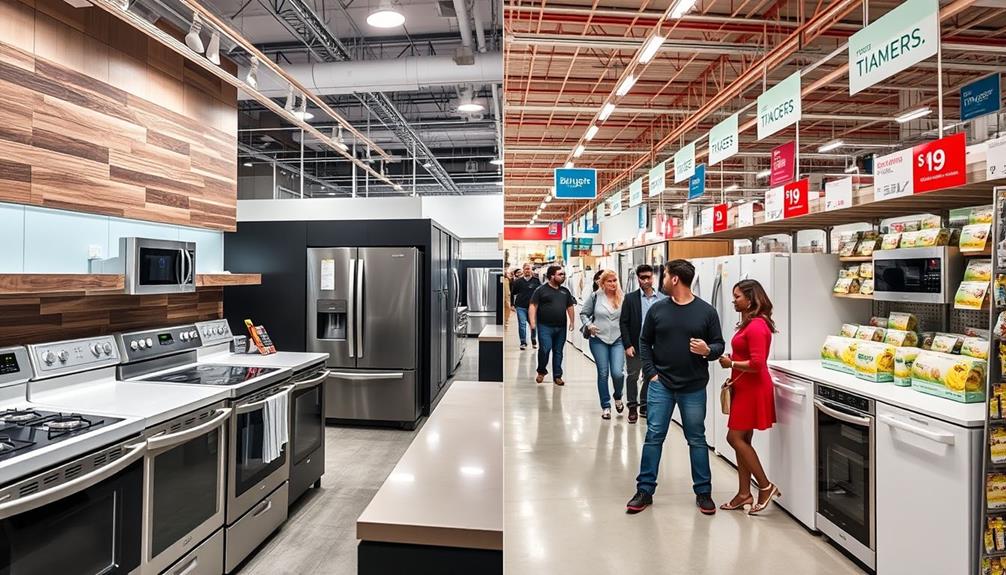
Competitive market dynamics create a landscape where appliance brands often have significant price disparities. When you're shopping for a wall oven, understanding these dynamics helps you make informed choices. Brands like Samsung and LG have captured market share by implementing competitive pricing strategies, appealing to consumers who prioritize quality and reliability.
Additionally, market trends indicate that similar competitive strategies are utilized in sectors like precious metals, where companies such as Noble Gold emphasize transparent fee structures to attract investors.
Key factors influencing these price differences include:
- Production Costs: Varying costs across regions can lead to lower prices for some brands, like German appliances that are more affordable in the US.
- Distribution Strategies: Brands employ different distribution methods, impacting final retail prices. In-store purchases often average $940, while online prices can be as low as $890.
- Brand Positioning: Companies position themselves based on consumer preferences, which can lead to significant variations in pricing structures.
In 2023, the average price for major appliances was $922, reflecting a trend toward budget-conscious buying.
As competitive retailers like Lowe's and Home Depot vie for your attention, you'll find that these market dynamics play an essential role in shaping the prices you see for the wall oven of your choice.
Consumer Perception of Value
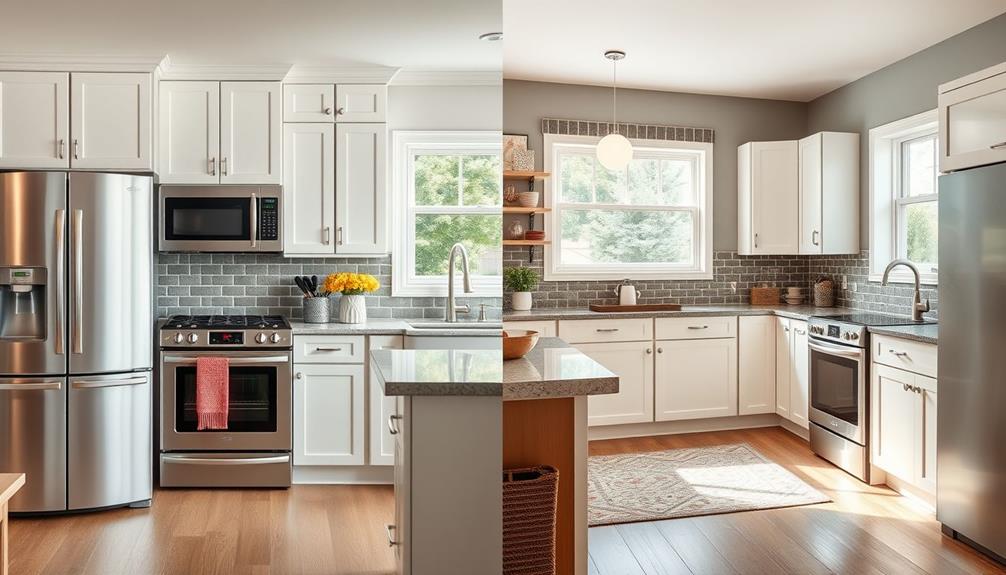
Understanding how competitive market dynamics shape pricing can greatly impact consumer perception of value in appliance brands. Price plays an essential role in how you evaluate home appliances. With the average cost of major appliances in 2023 being $922, many consumers are leaning towards budget-friendly options. Brand loyalty also greatly influences your choices, as 53% of shoppers stick to one store and 52% focus on a single brand during their search.
Additionally, trends in appliance colors and energy efficiency impact perceived value. For example, while white appliances remain popular, stainless steel options are gaining ground. You might also consider energy efficiency; modern dishwashers are now over twice as efficient as those from 1981, which can sway your decision towards brands that showcase these advancements.
To further illustrate how various factors influence your perception of value, here's a quick comparison:
| Factor | Consumer Impact |
|---|---|
| Price | Determines budget-friendly choices |
| Brand Loyalty | Influences store and brand selection |
| Color Preference | Affects aesthetic appeal |
| Energy Efficiency | Encourages eco-friendly options |
| Financing/Rebates | Enhances affordability perception |
Your perception of value ultimately shapes your purchasing decisions in the appliance market.
Economies of Scale Impact
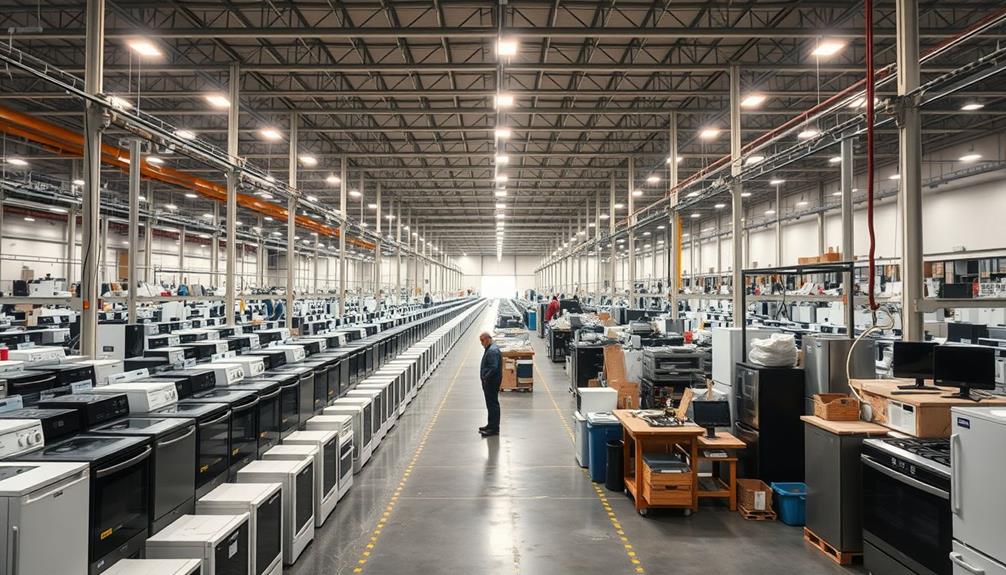
Economies of scale play an essential role in shaping appliance pricing and accessibility. When larger brands produce household appliances, they can greatly reduce per-unit costs by spreading fixed expenses over a greater number of products. This leads to lower prices for you, the consumer.
Consider these key factors:
- Major manufacturers like Samsung and LG benefit from extensive production facilities, allowing them to produce at lower costs.
- High demand for popular appliances enables these brands to negotiate better deals with suppliers, further slashing retail prices.
- Brands with substantial market share can invest in marketing and distribution efficiencies, keeping prices competitive.
In 2023, the average price for major appliances hit $922. Established brands leverage their economies of scale to offer both quality and affordability.
Smaller or niche brands, however, often struggle to compete as they lack the production volumes to achieve similar cost reductions. This means when you're shopping for household appliances, larger brands often provide better value, thanks to their ability to operate more efficiently.
Transparency in Branding
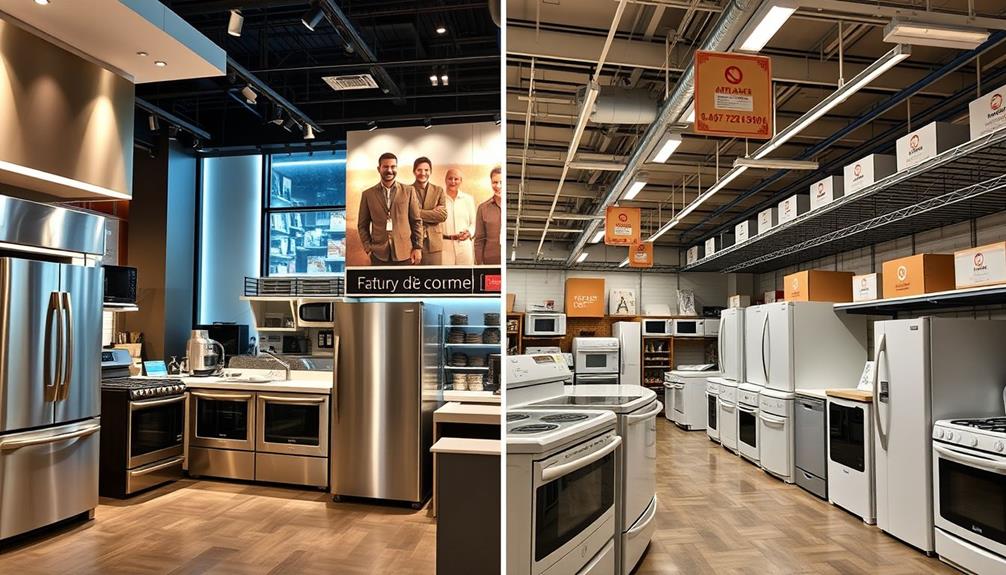
Maneuvering the appliance market can feel overwhelming, especially when many brands—like Kenmore and Frigidaire—market similar products under different names. This lack of transparency in branding creates confusion about who actually manufactures washing machines and other appliances. You might find multiple models listed in Consumer Reports that seem nearly identical, making it tough to determine which brand offers genuine quality.
Understanding keyword clustering can help you navigate through these complexities by organizing related information, leading to more informed purchasing decisions.
When you're renovating or upgrading your home, clear insights into product features and reliability become essential. Unfortunately, the overlapping brand names, such as GE Monogram ranges produced by DCS, only complicate your decision-making process. This blurring of lines can lead to frustration, as you may struggle to differentiate between high-end and budget-friendly options.
Additionally, unclear branding can foster misconceptions about product quality, pushing you toward choices that may not meet your expectations. As a consumer, you deserve transparency, especially in a market where trust and perceived value are vital.
Strategies for Smart Shopping

How can you make the most of your appliance shopping experience? With a few smart strategies, you can save considerably on your purchases.
Years ago, shoppers relied solely on price tags, but today, you have more tools at your disposal. For instance, understanding the aesthetic and functional elements of home design, such as those found in modern farmhouse bedrooms, can help you choose appliances that enhance your overall decor.
Here are three effective strategies to take into account:
- Research Trade Shows: Attend local trade shows to connect with representatives. You might find exclusive discounts or negotiate better deals on display models.
- Look for Rebates: Before finalizing your purchase, check for available rebates. Many brands offer money-back deals that can lower your costs greatly.
- Time Your Purchases: Plan your shopping around clearance events or monthly specials. You could save 30-50% on appliances if you time it right.
Frequently Asked Questions
Does It Matter if Your Appliances Are Different Brands?
It doesn't really matter if your appliances are different brands. What counts is their efficiency, features, and how well they suit your needs. Prioritize performance over brand loyalty for the best overall value.
Do More Expensive Appliances Last Longer?
If you invest in a high-end refrigerator, you'll likely notice it lasts over a decade. More expensive appliances often use better materials and technologies, leading to greater durability and fewer repairs compared to cheaper options.
Are High-End Appliances Worth the Money?
High-end appliances often offer advanced features, energy efficiency, and durability. If you value long-term savings and superior performance, investing in them can be worth it. They might initially cost more, but you'll benefit over time.
Which Appliances Are Built to Last?
When you're looking for appliances built to last, consider brands like Whirlpool and Bosch. Their durable materials and engineering guarantee longevity, often outlasting budget options, saving you money in the long run.
Conclusion
In the appliance market, price differences often stem from a mix of brand marketing strategies, material quality, and economies of scale. Did you know that brands producing over 1 million units annually can reduce their costs by up to 20%? This highlights how larger companies leverage their scale for competitive pricing. Understanding these factors can help you make informed choices that fit your budget without compromising on quality. So, next time you shop, keep these insights in mind!










